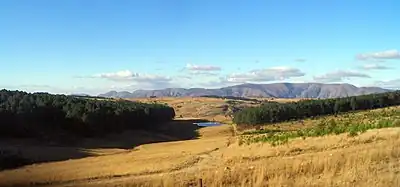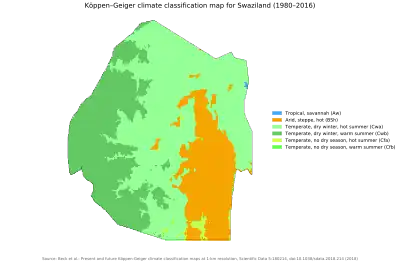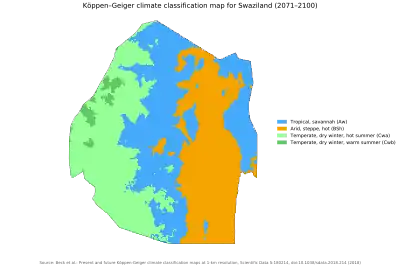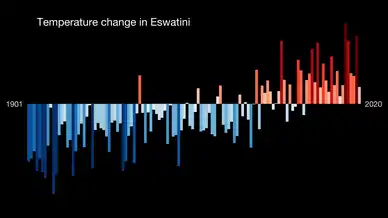
Eswatini also known as Swaziland, a landlocked nation located in Southern Africa, is characterized by a subtropical climate that features wet and hot summers as well as cold and dry winters.[1] The country has expressed concern regarding the impact of climate change on its existing social challenges, which include but are not limited to issues such as poverty, a high prevalence of HIV, and food insecurity. Furthermore, it is anticipated that climate change will significantly impede the country's development progress, by Vision 2022.[1]
Greenhouse gas emissions
The GHG mitigation assessment indicates that Eswatini emitted 4.5 million tonnes of greenhouse gas (GHG) emissions (equivalent to CO2) in the year 2017. The primary contributors to these emissions were the energy sector, as well as agriculture, forestry, and land use, accounting for 39% and 56% of the total emissions, respectively. Industrial processes and waste were also significant contributors.[2]
| Year | Fossil CO2
Emissions ( tons ) |
CO2 emisions
change |
CO2 emissions
per capita |
Population | Pop .
change |
Share of World's
CO2 emissions |
| 2016 | 657,572 | 2.61% | 0.58 | 1,142,524 | 0.76% | 0.00% |
| 2015 | 640,832 | 0.82% | 0.57 | 1,133,936 | 0.72% | 0.00% |
| 2014 | 635,623 | 3.98% | 0.56 | 1,125,865 | 0.67% | 0.00% |
| 2013 | 611,291 | 0.19% | 0.55 | 1,118,319 | 0.62% | 0.00% |
| 2012 | 610,106 | 0.59% | 0.55 | 1,111,444 | 0.55% | 0.00% |
| 2011 | 606,518 | 4.59% | 0.55 | 1,105,371 | 0.50% | 0.00% |
| 2010 | 579,907 | 6.57% | 0.53 | 1,099,920 | 0.46% | 0.00% |
| 2009 | 544,172 | 1.08% | 0.5 | 1,094,886 | 0.46% | 0.00% |
| 2008 | 538,345 | 3.46% | 0.49 | 1,089,870 | 0.54% | 0.00% |
| 2007 | 520,331 | 5.05% | 0.48 | 1,084,008 | 0.58% | 0.00% |
| 2006 | 495,335 | 7.54% | 0.46 | 1,077,735 | 0.55% | 0.00% |
| 2005 | 460,612 | 4.71% | 0.43 | 1,071,886 | 0.57% | 0.00% |
| 2004 | 439,907 | 1.83% | 0.41 | 1,065,764 | 0.66% | 0.00% |
| 2003 | 431,987 | 3.10% | 0.41 | 1,058,797 | 0.76% | 0.00% |
| 2002 | 418,997 | 0.84% | 0.4 | 1,050,809 | 0.90% | 0.00% |
| 2001 | 415,511 | 11.85% | 0.4 | 1,041,396 | 1.06% | 0.00% |
| 2000 | 371,474 | 55.86% | 0.36 | 1,030,496 | 1.19% | 0.00% |
| 1999 | 238,336 | 27.56% | 0.23 | 1,018,370 | 1.31% | 0.00% |
| 1998 | 186,841 | 0.69% | 0.19 | 1,005,158 | 1.46% | 0.00% |
| 1997 | 185,556 | 13.03% | 0.19 | 990,734 | 1.76% | 0.00% |
| 1996 | 164,161 | -3.18% | 0.17 | 973,587 | 2.10% | 0.00% |
| 1995 | 169,559 | 8.43% | 0.18 | 953,573 | -0.02% | 0.00% |
| 1994 | 156,370 | -15.36% | 0.16 | 953,737 | 0.03% | 0.00% |
| 1993 | 184,738 | -5.71% | 0.19 | 953,451 | 3.06% | 0.00% |
| 1992 | 195,934 | -20.53% | 0.21 | 925,165 | 3.98% | 0.00% |
| 1991 | 246,535 | -0.70% | 0.28 | 889,712 | 4.18% | 0.00% |
| 1990 | 248,264 | -11.05% | 0.29 | 854,011 | 3.40% | 0.00% |
| 1989 | 279,096 | -13.93% | 0.34 | 825,952 | 3.97% | 0.00% |
| 1988 | 324,267 | -31.62% | 0.41 | 794,434 | 4.71% | 0.00% |
| 1987 | 474,182 | 48.83% | 0.63 | 758,669 | 3.91% | 0.00% |
| 1986 | 318,604 | -3.36% | 0.44 | 730,150 | 3.95% | 0.00% |
| 1985 | 329,670 | 38.99% | 0.47 | 702,400 | 3.71% | 0.00% |
| 1984 | 237,182 | -3.55% | 0.35 | 677,303 | 3.33% | 0.00% |
| 1983 | 245,900 | -35.26% | 0.38 | 655,505 | 3.32% | 0.00% |
| 1982 | 379,828 | -25.89% | 0.6 | 634,439 | 2.96% | 0.00% |
| 1981 | 512,539 | -3.37% | 0.83 | 616,210 | 2.95% | 0.00% |
| 1980 | 530,394 | -21.85% | 0.89 | 598,564 | 3.36% | 0.00% |
| 1979 | 678,731 | 13.96% | 1.17 | 579,091 | 3.37% | 0.00% |
| 1978 | 595,578 | 39.48% | 1.06 | 560,236 | 3.30% | 0.00% |
| 1979 | 678,731 | 13.96% | 1.17 | 579,091 | 3.37 % | 0.00% |
| 1980 | 530,394 | -21.85% | 0.89 | 598,564 | 3.36% | 0.00% |
| 1979 | 678,731 | 13.96% | 1.17 | 579,091 | 3.37% | 0.00% |
| 1978 | 595,578 | 39.48% | 1.06 | 560,236 | 3.30% | 0.00% |
| 1977 | 426,992 | 8.09% | 0.79 | 542,328 | 3.21% | 0.00% |
| 1976 | 395,028 | -19.82% | 0.75 | 525,457 | 3.12% | 0.00% |
| 1975 | 492,688 | -7.55% | 0.97 | 509,535 | 3.01% | 0.00% |
| 1974 | 532,912 | 8.70% | 1.08 | 494,624 | 2.90% | 0.00% |
| 1973 | 490,278 | 26.00% | 1.02 | 480,668 | 2.81% | 0.00% |
| 1972 | 389,114 | -13.54% | 0.83 | 467,512 | 2.77% | 0.00% |
| 1971 | 450,072 | 0.04% | 0.99 | 454,913 | 2.72% | 0.00% |


Climatology
The mean annual rainfall in South Africa varies from approximately 1,500 mm in the northern Highveld to 500 mm in the southern lowland. The rainiest periods occur from November to February, coinciding with the typically hottest time of the year. The mean monthly temperature ranges from 15°C to 23.4°C. During this period, the mean monthly precipitation ranges from 11.9 mm in June to 143.3 mm in January. As a result, the country experiences an average annual rainfall of over 800 mm, based on the latest climatology from 1991-2020.[4]
Climate change impacts
Swaziland is situated in the summer rainfall region of the subcontinent, where approximately 80% of the precipitation occurs during the summer months, specifically from October to March. The climate also experiences significant temperature and precipitation variations from west to east due to an altitude decrease of around 4,000 feet over a distance of about 80 kilometers.[5]
Health sector
Climate change is expected to adversely affect Swaziland's health sector. Increased temperatures may lead to a rise in vector-borne diseases, posing a significant threat.[6][7][8]
Food and water insecurity
.jpg.webp)
Severe droughts have rendered 25% of the population in Swaziland vulnerable, facing challenges of food and water insecurity. These consequences are linked to climate change impacts.[9]
Water resource management
Climate change is anticipated to cause overall warming and drying in Swaziland, leading to more frequent and intense droughts and floods. Adaptation initiatives focus on managing water resources in response to these changes.[10]
Food production

Climate change has been attributed to the decline in food production in Swaziland. Visible effects underscore the reality and urgency of addressing climate change impacts.[5]
Mitigation and adaptation strategies
The government of Eswatini has taken several steps to mitigate and adapt to climate change. These include the development of a National Climate Change Strategy and Action Plan, which outlines the country's vision and objectives for climate change adaptation and mitigation. The country has also implemented a number of projects aimed at reducing greenhouse gas emissions and promoting renewable energy, including the installation of solar panels on public buildings and the promotion of energy-efficient lighting.[11]
See Also
References
- 1 2 "World Bank Climate Change Knowledge Portal". climateknowledgeportal.worldbank.org. Retrieved 2023-12-21.
- ↑ Gcina, Mavimbela; Nosiphiwo, Zwane; Mduduzi, Mathunjwa; Thembinkosi, Ndzimandze; Gugu, Vilakati (June 2021). "Greenhouse Gas Mitigation Assessment to Inform the update of Eswatini's Nationally Determined Contribution" (PDF). UN.
- ↑ "Switzerland: carbon dioxide emissions 1970-2022". Statista. Retrieved 2023-12-21.
- ↑ "World Bank Climate Change Knowledge Portal". climateknowledgeportal.worldbank.org. Retrieved 2023-12-21.
- 1 2 "Swaziland: Facing climate change - Eswatini | ReliefWeb". reliefweb.int. 2007-07-20. Retrieved 2023-12-21.
- ↑ "Swaziland | UNDP Climate Change Adaptation". www.adaptation-undp.org. Retrieved 2023-12-21.
- ↑ "Environmental burden of disease: Swaziland". www.who.int. Retrieved 2023-12-21.
- ↑ Shongwe, Samuel S (2015). "National Report on Climate Change" (PDF). Swaziland’s First National Communication to the UNFCCC.
- ↑ "World Bank Climate Change Knowledge Portal". climateknowledgeportal.worldbank.org. Retrieved 2023-12-21.
- ↑ "Adapting Water Resource Management In Swaziland To Manage Expected Climate Change | UNDP Climate Change Adaptation". www.adaptation-undp.org. Retrieved 2023-12-21.
- ↑ "Swaziland- Second National Communication | UNDP Climate Change Adaptation". www.adaptation-undp.org. Retrieved 2023-12-21.

